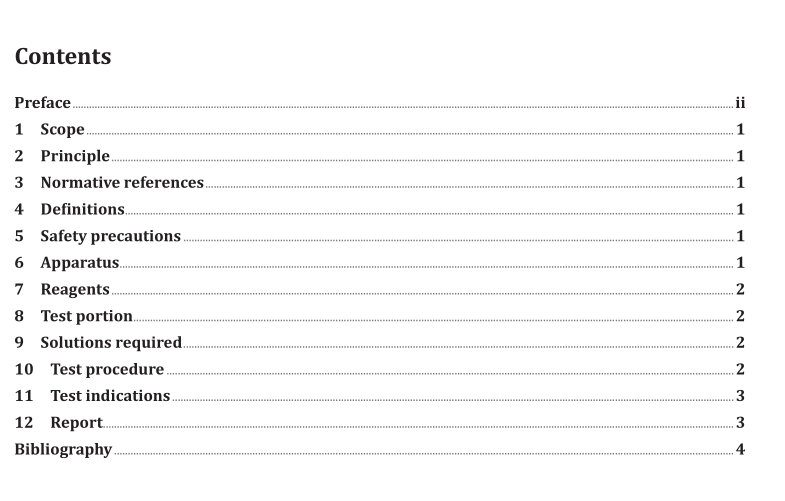AS 1141.34 pdf download – Methods for sampling and testing aggregates Method 34: Organic impurities other than sugar

AS 1141.34 pdf download – Methods for sampling and testing aggregates Method 34: Organic impurities other than sugar
1 Scope
This Standard sets out a method for an approximate determination of the presence of organic materials,other than sugar, present in fine aggregate.
2Principle
The test relies on the reaction of humus material with a sodium hydroxide solution to produce a darkcolour in the liquid the intensity of which is approximately proportionate with the mass contentof humus in the fine aggregate. Based on 1917 research, fine aggregate with humus contents thathave a resultant solution colour lighter than, or equal to, the Standard colour are expected to haveno detrimental effects when used in concrete or mortar products. A darker coloured solution maybe the result of humus content and/or reactions from other contaminents and may require furtherinvestigation to determine the extent of possible effects to concrete or mortar properties.
3Normative references
The following documents are referred to in the text in such a way that some or all of their contentconstitutes requirements of this document.
AS 1141.2,Methods for sampling and testing aggregates,Part 1: Definitions
AS1141.2,Methods for sampling and testing aggregates,Method 2:Basic testing equipmentAS 1141.3.1, Methods for sampling and testing aggregates, Method 3.1:Sampling Aggregates
4 Definitions
For the purpose of this Standard the definitions in AS 1141.1 apply.
5 Safety precautions
Procedures using strong alkalis, including the preparation of dilute solutions of these chemicals, shouldbe carried out with care.
WARNING – STRONG ALKALIS ARE HAZARDOUS AND CAN RESULT IN OFTEN IRREVERSIBLEDAMAGE TO THE SKIN OR EYES.INGESTION OF THE CHEMICAL, INHALATION OF THE FUMES, ORSKIN CONTACT CONSTITUTES A SERIOUS HEALTH HAZARD.
Appropriate documentation should be consulted as to safety precautions.
6Apparatus
The following apparatus, conforming to the relevant provisions of AS 1141.2, is required:(a Stoppered rectangular clear glass bottles — of approximately 350 mL or greater capacity.
NOTESuitable bottles were known as graduated prescription bottles. Other containers may be usedprovided the light path for the comparison test is the same for the test solution and the standard solution[see Clause 10(c)]. European Standard EN 1744-1:2009 specifies a clear, cylindrical stoppered glass bottleapproximately 450 mL with an external diameter of 70 mm.
7Reagents
All reagents shall be of analytical grade. The following reagents are required:(aSodium hydroxide.
(b)Tannic acid.
(Ethanol.
(d) Distilled or deionized water.
Test portion
By coning and quartering or using sample dividers, take a test portion of approximately 100 g from alaboratory sample obtained in accordance with the procedures of AS 1141.3.1.The test portion shall beused in the condition in which it was received.
9 solutions required
The following solutions are required:
(aSodium hydroxide solution — A solution of 30 g of sodium hydroxide in 970 mL of distilled ordeionized water.
(b) Reference colour solution —Two grams of tannic acid shall be dissolved in 10 mL of ethanol (ethyl
alcohol), and the solution diluted to 100 mL with distilled water, then 2.5 mL of the resultantsolution shall be added to 97.5 mL of the 3 % sodium hydroxide solution. The mixture shall beshaken vigorously and then allowed to stand in subdued light for 1 h before use.The referencecolour solution shall be used within 2 h of its preparation [see Clause 10(c)].
10Test procedure
The test procedure shall be as follows:
(a)Pour about 50 mL of 3 % sodium hydroxide solution into a 250 mL measuring cylinder or similar
calibrated clear vessel.Add the fine aggregate to the 125 mL mark and adjust the sodium hydroxidelevel to the 200 mL mark with more solution(after removal of bubbles by shaking).
(b)Vigorously shake the mixture for not less than 30 s, taking care to ensure thatall the fine aggregates
are thoroughly wetted by the sodium hydroxide solution and that any lumps are dispersed.Aftershaking. allow the mixture to stand for 24 h± 15 min.
(At the end of the 24 h standing period, place 100 mL of reference colour solution in a rectangular
clear glass bottle, and transfer 100 mL of the supernatant liquid from the test to a similar bottle.(d) Compare the colour of the test solution to the colour of the reference when both are viewed in
similar light conditions and the light paths through the solutions to the viewer are of the samelength and angle.
Or, as an alternative to Item (d), either:
(i)Compare the colour of the supernatant liquid, viewed through the thickness of the glass bottle
with the colour of a standardized glass sheet.In this case the standardized glass plate shall becompared to the reference solution in a bottle with a light path that allows the viewed colourof the solution to match the colour of the glass plate.Once this is determined, the test solutionshall be contained in a bottle with the same length light path; or









